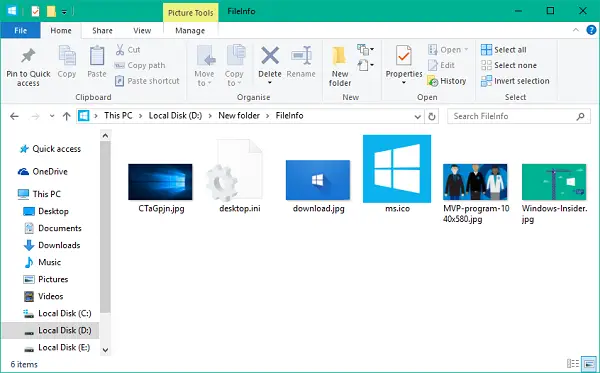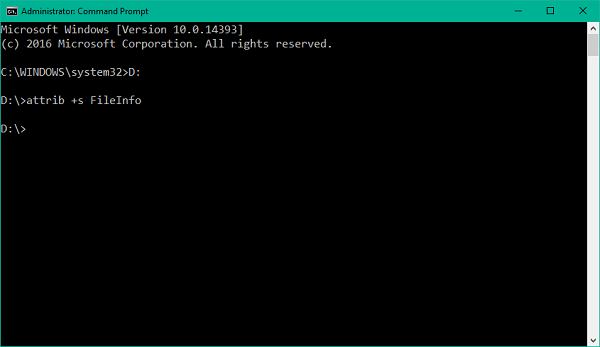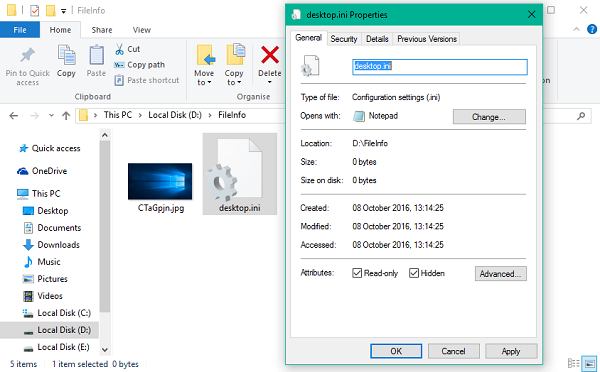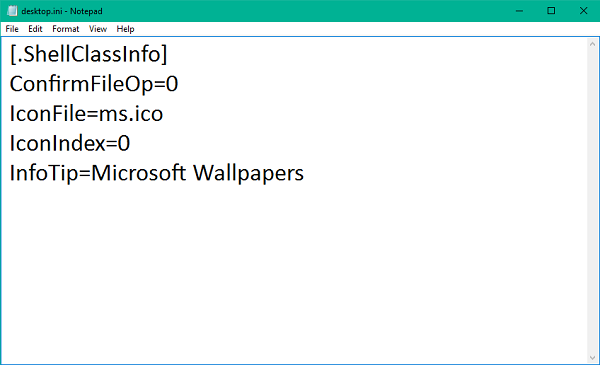If y'all guide maintain ever configured the folder settings on your Windows PC together with enabled the visibility of hidden files, y'all powerfulness guide maintain noticed the desktop.ini file resting on your desktop, equally good equally inwards each folder. What is this desktop.ini file inwards Windows 10/8/7? Is it a virus? If yes, how tin I delete it? If no, what exercise does it serve? This postal service volition explicate all your basic questions regarding the desktop.ini file. We volition also guide maintain a await at how to customize folders using a desktop.ini file.
What is desktop.ini file together with what is its purpose
A Desktop.ini file is a hidden Windows operating arrangement configuration settings file located inwards every folder, that determines how the folder is displayed along alongside its other Properties – similar the icon used for that folder, its localized name, sharing properties, etc.
In Windows, y'all tin easily configure the way whatever file/folder is shared, accessed yesteryear a normal user, how it tin hold upwards shared together with other settings that command how that file/folder permissions are imposed. All this data most the presentation of that folder is saved inwards the desktop.ini file, which is default initialization file format.
Now, if y'all alter the configuration together with layout settings of a folder, those changes are automatically stored on the desktop.ini file of that special folder. This is a hidden file, which agency that y'all guide maintain to uncheck “Hide protected operating arrangement files” inwards the File Explorer Options.
Is desktop.ini a Virus
This desktop.ini hidden operating arrangement file is non a virus. This is a native arrangement file that is stored on folder level, created in ane lawsuit you’ve customized the background, icon or thumbnail image, etc. However, in that place has been a history of Trojan virus associated alongside this name. If a desktop.in file is visible fifty-fifty when y'all guide maintain checked the options to shroud hidden equally weel equally the arrangement files, it could hold upwards malware. Hence, to hold upwards sure, y'all tin e'er scan your figurer using your antivirus program.
Can I delete desktop.ini file
Well, yes y'all can, but together with thus your folder’s display settings volition hold upwards restored to default. It is similar this – whenever y'all alter the folder icon or the thumbnail ikon for that matter, sharing properties, etc., all this data gets stored on the desktop.ini file automatically. Now, what would come about if y'all delete this file from that folder? You guessed it right! Your configured changes volition hold upwards lost, together with folder settings volition hold upwards switched to system-wide default.
If y'all delete it once, it volition hold upwards automatically regenerated the side yesteryear side fourth dimension y'all customize your folder settings. Now, this procedure of automatic generation can’t hold upwards turned off equally it is a defined procedure at the OS level. However, y'all tin guide to shroud it from the full general persuasion thus that it does non bother y'all alongside its presence.
How to customize folder using desktop.ini file
Customizing a folder using desktop.ini file is no geeky stuff. You but remove to create/update the desktop.ini file native to that folder to update its persuasion together with appearance settings. Below are a few noteworthy things that y'all tin exercise yesteryear playing roughly the desktop.ini file:
- Assign a custom icon or thumbnail ikon to the raise folder
- Create an information tip which provides data most the folder when y'all hover the cursor over the folder
- Customize the way folder is shared or accessed
Follow these steps to modify a folder’s fashion using desktop.ini file.
1. Choose whatever folder that y'all wishing to customize using desktop.ini. Make certain that y'all conk along the backup of your files elsewhere thus that it tin hold upwards restored inwards illustration anything goes wrong.
2. Run the next command to brand the chosen folder a arrangement folder. This volition educate a Read-only flake on the underlying folder together with enable a special behavioral feature for the desktop.ini file.
attrib +s FolderName
3. Create a desktop.ini file for the folder inwards question. Make it hidden together with label it equally a system file thus that it restricts the normal users from accessing the same. You tin exercise thus yesteryear enabling the Read-only and Hidden flags in Properties window of the desktop.ini file.
Note: The desktop.ini file y'all exercise should hold upwards inwards Unicode file format thus that the localized strings stored inwards it equally content is readable to the intended users.
4. Here is my sample of the desktop.ini file created for a folder named FileInfo, equally shown inwards the images.
[.ShellClassInfo]ConfirmFileOp=0IconFile=ms.icoIconIndex=0InfoTip=Microsoft Wallpapers
Now, let’s guide maintain a await at what does all the content inwards the desktop.ini file means:
- [.ShellClassInfo] – It initializes the arrangement belongings which allows y'all to customize the underlying folder yesteryear assigning values to the several attributes that tin hold upwards defined inwards a desktop.ini file.
- ConfirmFileOp – Set this to 0, together with y'all won’t acquire the alert You Are Deleting a System Folder while deleting/moving the desktop.ini file.
- IconFile – If y'all desire to educate a custom icon for your folder, y'all tin specify the icon file mention here. Make certain to banking concern tally the absolute path of the file. Specify the amount path if the file is non inwards the same location. Also, .ico file is preferred for setting custom icons, although it is possible to specify the .bmp, .dll files equally good which contains icons, but that’s a story for another day.
- IconIndex – If you’re setting a custom icon for the underlying folder, y'all remove to educate this entry equally well. Set it to 0 if in that place is alone ane icon file inwards the file specified for IconFile attribute.
- InfoTip – This special attribute is used to educate a text string which tin hold upwards used equally an Informational Tip most the folder. If y'all educate this entry to a text string together with and thus hover the cursor over the folder, the text string stored inwards the desktop.ini file is displayed there.
See it inwards activeness below –
Let us know inwards comments department below if y'all guide maintain whatever other dubiety regarding the desktop.ini file inwards Windows 10.
Looking to larn to a greater extent than most other processes, files, file types or formats inwards Windows? Check these links:
Windows.edb files | Thumbs.db files | DLL together with OCX files | NFO and DIZ files | Swapfile.sys, Hiberfil.sys & Pagefile.sys | Index.dat file | Desktop.ini file | Svchost.exe | WinSxS | RuntimeBroker.exe | StorDiag.exe | nvxdsync.exe | Shellexperiencehost.exe | Hosts file |WaitList.dat file.
Source: https://www.thewindowsclub.com/






comment 0 Comments
more_vert